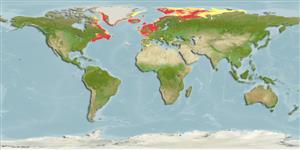Common names from other countries
Classification / Names / Names
ماع يماسا | فدارتم | Catalog of Fishes (gen., sp.) | ITIS | CoL | WoRMS
Environment: milieu / climate zone / depth range / distribution range
يسانش موب
; قمع تارييغت 0 - 265 m (Ref. 119532). Polar; 82°N - 35°N, 70°W - 116°E
Northern Atlantic, Arctic and the Mediterranean: from Ungava, Canada to Morocco in the south, north to Arkhangelsk Russia and west to Laptev Sea. Mostly polar, but also in subtropical and boreal.
Length at first maturity / Size / Weight / نس
Maturity: Lm ? range ? - ? cm
Maximum depth from Ref. 119536. Solitary (Ref. 2377). Abundant in sublittoral banks and shallow seas (Ref. 119529). Predator/scavenger (Ref. 119532).
Life cycle and mating behavior
غولب | لثم دیلوت | یزیر مخت | اه مخت | Fecundity | )ورال ( دازوت
Members of the class Anthozoa are either gonochoric or hermaphroditic. Mature gametes are shed into the coelenteron and spawned through the mouth. Life cycle: The zygote develops into a planktonic planula larva. Metamorphosis begins with early morphogenesis of tentacles, septa and pharynx before larval settlement on the aboral end.
یلصا ذخآم
عجارم | هدننك گنهامه | ناراكمه
Cairns, S.D., D.R. Calder, A. Brinckmann-Voss, C.B. Castro, D.G. Fautin, P.R. Pugh, C.E. Mills, W.C. Jaap, M.N. Arai, S.H.D. Haddock and D.M. Opresko. 2003. (Ref. 1663)
NCUI زمرق تسرهف رد تيعضو (Ref. 130435)
ستياس رظن زا تيعضو (Ref. 108899)
Not Evaluated
Not Evaluated
یناسنا هدافتسا
| FishSource |
اهرازبا
رتشيب تاعالطا
Age/Size
دشر
نزو - لوط
لوط - لوط
يسانش تخير
)ورال ( دازوت
يناوارف
يتنرتنيا عبانم
Estimates based on models
تميق هقبط
Unknown.
